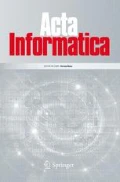Abstract
A class of propositional formulas, encoding the property that every finite, transitive digraph with no two-cycles must have a source, has been investigated by Krishnamurty and conjectured as hard for resolution. In this note we prove, opposed to that conjecture, that there are proofs of polynomial lengths (or even linear in the lengths of the formulas) of those formulas.
Similar content being viewed by others
References
Buss, S.R.: Polynomial size proofs of the propositional pigeonhole principle., J. Symbolic Logic 52 (1987)
Cook, S.A.: A short proof of the pigeonhole principle using extended resolution. SIGACT News 8 (1976)
Cook, S.A., Reckhow, R.A.: The relative efficiency of propositional proof systems. J. Symbolic logic 44 (1979)
Franzen, T.: Algoritmic aspects of intuitionistic propositional logic, SICS Research Report R87010, 1987
Haken, A.: The intractability of resolution. Theoret. Comput. Sci. 39 (1985)
Hansenjaeger, G.: Über eine Art von Unvollständigkeit des Prädikatenkalküls der ersten Stufe. J. Symbolic Logic 15 (1950)
Hilbert, D., Bernays, P.: Grundlagen der Mathematik, Berlin: Springer 1934.
Krishnamurty, B.: Short proofs for tricky formulas. Acta Informatica 22 (1985)
Tseitin, G.S.: On the complexity of derivations in propositional calculus. Studies in mathematics and mathematical logic, Part II, 1968.
Author information
Authors and Affiliations
Rights and permissions
About this article
Cite this article
Stålmarck, G. Short resolution proofs for a sequence of tricky formulas. Acta Informatica 33, 277–280 (1996). https://doi.org/10.1007/s002360050044
Received:
Issue Date:
DOI: https://doi.org/10.1007/s002360050044



